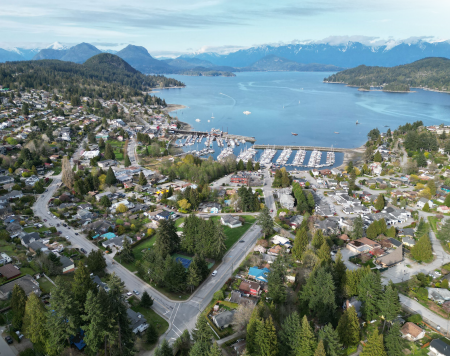The Town of Gibsons has endorsed an ambitious urban forest plan to protect and expand tree canopy coverage across the municipality by 2045.
The plan, developed by Diamond Head Consulting, was presented to council during the June 3 regular meeting, following community engagement and technical analysis.
The urban forest plan establishes canopy cover targets of 31 per cent for urban areas and 39 per cent for greenfield development sites by 2045.
Currently, Gibsons maintains 38 per cent overall canopy coverage, representing 160 hectares of tree canopy within the town's 430-hectare(4.3km²) boundary.
The plan notes that while greenfield areas will see reduced canopy due to expected development, strategic planting and protection measures can still achieve meaningful coverage.
Matt Shields, a registered professional forester with Diamond Head Consulting, presented the plan's key components, including four main goals: protecting and growing the urban forest, stewarding trees as municipal assets, partnering to increase awareness and capacity, and monitoring progress.
The plan proposes planting 2,200 additional trees over 20 years—1,000 in parks, 1,200 along streets, plus 500 on private property through community tree programs.
Council members raised concerns about implementation, particularly regarding street tree placement. Coun. David Croall highlighted ongoing challenges with trees damaging infrastructure like sidewalks and roads, emphasizing the need for better planning to prevent conflicts between urban forest goals and infrastructure maintenance.
"We're continually planting trees that disturb infrastructure," Croal noted, referencing Southern Ontario communities where he grew up that have created tree-lined corridors without infrastructure damage.
Trevor Rutley, director of infrastructure services, acknowledged competing priorities within limited road corridor space, noting that the urban forest plan must be balanced against the Active Transportation Plan and the upcoming parking strategy.
He added that different streets may require prioritization of various municipal goals depending on neighbourhood needs and road types.
Council also discussed strengthening tree protection measures for private property development. The plan recommends updating the tree preservation bylaw and exploring minor variance provisions that would allow developers flexibility in parking and setback requirements to preserve mature trees.
Regarding invasive species management, Coun. Annemarie De Andrade expressed concern about the timeline for implementing integrated management plans, given the volume of Scotch broom and other invasive species on private properties.
Michelle Lewis, natural asset technician, noted that effective invasive species bylaws face practical challenges, especially for species like knotweed that require specialized disposal methods.
She explained “invasive species” is a broad term and, “Having a bylaw to say to remove blackberries is a lot different than a bylaw to remove knotweed,” as knotweed must be burned or buried, and cannot be transported off-Coast to do so.
Director of Finance William Wallace touched on funding, noting that the required tree planting could cost approximately $22,000 annually.
However, BC Hydro's greening grants could cover half the cost, and existing parks budget allocations could address much of the remainder, he said.
Additional federal funding through programs like Green Canada's Community Canopies offers further financial support opportunities.
The plan comes from thorough community engagement, including surveys and public meetings that showed strong support, with 83 per cent of respondents endorsing the proposed planting targets.
Council endorsed the plan with the condition that staff develop a detailed implementation strategy addressing budget considerations and competing municipal priorities.
The urban forest plan aims to be integrated into the Official Community Plan, providing a policy framework for future tree protection and planting initiatives across Gibsons.
Jordan Copp is the Coast Reporter’s civic and Indigenous affairs reporter. This reporting beat is made possible by the Local Journalism Initiative.
Words missing in article? Your adblocker might be preventing hyperlinked text from appearing.



